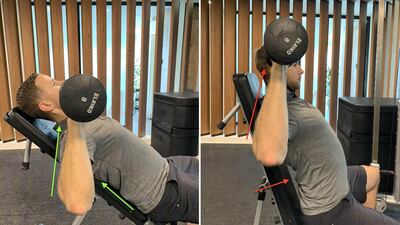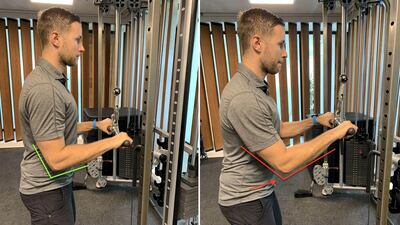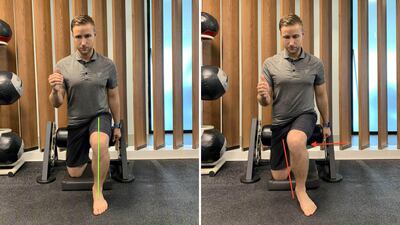January inevitably brings with it a rise in interest in gymnasiums, exercise classes and active sports. Last year, for instance, UAE gyms anticipated as much as a 40 per cent surge in membership, resulting in some establishments offering to absorb the cost of VAT. The reasons are aplenty – people feel the need to shed the extra kilos they've gained over the holidays, or they want to embrace a new year on a positive note, try something different or simply challenge themselves, and so resolve to get fitter and faster.
The latter goal, ironically, can be detrimental to health. Going from zero or even halfway to full tilt when it comes to working out or taking up a sport can result in physical and mental burnout.
Why fitness resolutions don’t work
"The truth about fitness resolutions is that, most of the time, they are unrealistic," says Oliver Linsenbarth , a kinesiologist with Diversified Integrated Sports Clinic, which provides preventive and palliative solutions at its JLT and Dubai HealthCare City branches. "I've seen people come in wanting to lose 40 kilograms, then getting into a new workout routine or sport too intensely, too soon," he says.

According to a University of Scranton study, only 8 per cent of people achieve their new year's goals. Linsenbarth chalks this down to overly ambitious resolutions. Instead of aiming to lose a bulk of weight in one go, he advises enthusiasts to start small – look at getting rid of two kilograms, for instance, and take things from there.
“To achieve fitness goals over a long period of time, you need to be consistent and you need to be healthy,” he says. “There is no point in working out to the point where your body is breaking down. It’s more important to be able to exercise every day, even if it is for a little bit, rather than go all out on day one and then be unable to do anything for the next three.
"People think training hard is going to get them immediate results, and it couldn't be further from the truth – workouts usually make you worse," Linsenbarth says. "It's how you recover from the workout and keep going that makes the difference."
He believes that in these cases, social media might be detrimental to one's long-term fitness plans. #Fitspo, the trend of putting up posts and pictures encouraging people to live healthier lives, may be common, and information on workout routines has never been more widespread and accessible, yet Linsenbarth argues it can make things harder for those resolving to be fitter. "You'll find a lot of people online talking about the amazing, seemingly nature-defying ways in which they lost weight, but there's only a select few who can do that," he says. "If someone else tries to the same but doesn't get the results they want, it can be depressing and cause them to give up prematurely."

Avoid fitness injuries
Whether it's because of the pressure that comes with social media or the need for quick results, rushing into a workout routine can also lead to more serious problems, such as exercise-related injuries. Jamie Bassi, a personal trainer with Fit Squad Dubai who specialises in high-intensity interval training, CrossFit and boxing, cautions against skipping a warm-up. "Basic stretches are a must. If they're not done, muscles tend to get too tight, which in turn prevents the whole range of motion a body is capable of when exercising. Other muscles usually take the stress, and it isn't long before you pull one or have an injury."
Linsenbarth says the most common activities people take up are running and cycling, with strength training and CrossFit also being popular in the UAE. While we assume activities such as running are harmless, problems can arise with just about any activity if a person's "movement patterns" aren't right. Running wrong, for instance, can cause ankle, hip, lower back and shin pain. "As with all sports and activities, there is a higher risk of injury if you don't know what you're doing," he says. "That being said, any sport that requires you to perform an activity at a higher speed is more problematic. Remember, the slower your movements, the less the risk of injury."
Nishi Bassi, a finance manager who lives in Dubai, reiterates the importance of correct form. "I downloaded a fitness app because I saw a lot of people doing that. But while it was telling me what to do, there was no way it could actually check my form. I ended up hurting my knee during a squat, because I wasn't placing my weight in the right place," she says. Her injury took three months to heal.
While the right stance is crucial, so is the use of proper equipment, so find the right trainer and ensure your gym's equipment is in proper order before your workout. Learning how to use a machine and setting it up properly goes a long way; merely using whatever configurations it's already set to is a big no-no. Linsenbarth also advises routine medical check-ups to see if there are any underlying issues that could get worse if a person continues to push themselves.
Finally, Jamie emphasises the importance of getting quality sleep if you’re hitting the gym regularly. “Lack of sleep can prevent weight loss, lead to low energy levels and affect your concentration. It also increases the risk of injury. If you’re not sleeping enough, you’re not allowing your body to recover after a workout, which affects the results.”
Don't stop moving
Should you suffer a strain or injury anyway, beware of falling off the fitness wagon altogether. Linsenbarth says the worst thing someone who has gone through an exercise-related mishap can do is stop. "You need to keep moving in order to get better. That doesn't mean you have to do something painful, but if you stop moving, you get weaker and it takes longer to heal. Consult a healthcare practitioner and adapt a workout accordingly."
This does, however, depend on the type of injury. Linsenbarth encourages those who are injured – even temporarily bedridden – to get creative. People can still exercise the parts of the body that are healthy and find exercises that don't stress the injured area. "I always tell people do to what they love," says Linsenbarth. This could be a walk on the beach or a low-impact dance class. "That way, you don't feel the pain as much and instead feel better about yourself."
Injury-prone areas and how to deal with them
Hips: The figure-four stretch can help. Lie on your back with your feet on the floor. Cross your right ankle over your left knee and keep your right foot flexed. Bring your left knee towards your chest. Reach your right hand through your legs and interlace your fingers below the crease of your left knee. Using your arms, pull your left knee towards your chest, pausing when you feel a stretch in your right glute and hip. Repeat on the left side.
Back: Lying down provides support and can stabilise the muscles around the back. These muscles need to be relaxed to get movement back. Try exercises from the ground up – start with rolls, get to the hands and knees, lift one foot and then the second.
Shoulders: Identifying the problem is the first step to getting rid of discomfort in this case. Test if you can raise your shoulder enough to lift your
elbow / arm above your head. A lacrosse ball or foam roller can help, as can strength and conditioning programmes.
Knees: Strengthening and improving the range of motion in the hips or ankles could ease knee pain.
Source: Diversified Integrated Sports Clinic. These are general tips and should not be used in lieu of a visit to a medical practitioner


